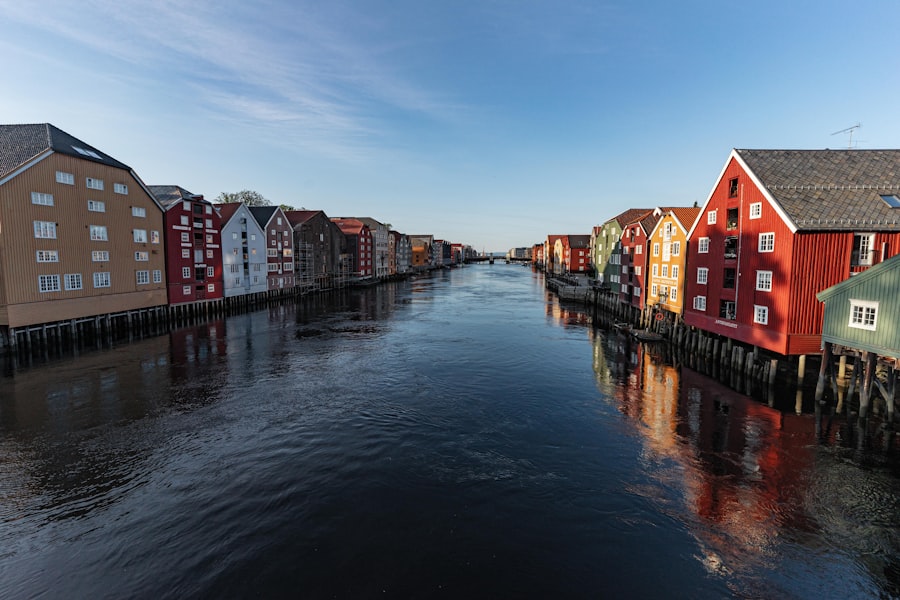Navigating the intricacies of workplace attire can be a daunting task, especially for those new to a country. In Norway, the dress code is often a reflection of the nation’s cultural values, which emphasise equality, simplicity, and practicality. Understanding the nuances of what is deemed appropriate can significantly ease the transition for expatriates and newcomers.
The Norway Relocation Group is an invaluable resource in this regard, offering guidance and support to help individuals acclimatise to their new environment. By providing insights into local customs and expectations, they ensure that newcomers can confidently navigate the complexities of Norwegian workplace attire. The dress code in Norway is not merely a set of rules; it is a manifestation of the country’s egalitarian ethos.
Unlike in some cultures where hierarchy dictates attire, Norwegian workplaces tend to favour a more relaxed approach. This article will delve into the various aspects of dress codes in Norway, exploring how cultural influences shape workplace attire and providing practical advice for those looking to fit in seamlessly. Schedule a one-on-one consultation with our relocation specialists to simplify your move to Norway. https://norwayrelocation.no/one-hour-strategy-session/
Summary
- Norwegians generally have a relaxed approach to dress code in the workplace, reflecting their informal and egalitarian culture.
- Casual dress code is widely accepted in Norwegian workplaces, with jeans and t-shirts being common attire.
- Business casual dress code in Norway typically includes smart trousers or skirts with a collared shirt or blouse, but ties and formal suits are not necessary.
- Corporate dress code in Norway leans towards formal attire, with suits and ties being more common, especially in traditional industries.
- Dress code expectations for men and women in Norwegian workplaces are generally similar, with an emphasis on comfort and practicality.
The Influence of Norwegian Culture on Workplace Attire
Norwegian culture is deeply rooted in values such as modesty, equality, and functionality. These principles are reflected in the way people dress for work. The emphasis on egalitarianism means that there is less of a distinction between different levels of employees when it comes to attire.
This cultural backdrop fosters an environment where individuals feel comfortable expressing their personal style while adhering to a general standard of professionalism. Moreover, the practicality inherent in Norwegian culture plays a significant role in shaping workplace attire. Given the country’s varied climate and outdoor lifestyle, clothing choices often prioritise comfort and functionality over ostentation.
This practical approach extends to the workplace, where employees are encouraged to dress in a manner that allows them to perform their duties effectively while still maintaining a professional appearance. Understanding these cultural influences is essential for newcomers who wish to integrate smoothly into Norwegian work environments.
Understanding the Different Levels of Dress Code: Casual, Business Casual, and Corporate

In Norway, dress codes can generally be categorised into three main levels: casual, business casual, and corporate. Each level serves a distinct purpose and is appropriate for different contexts within the workplace. Casual attire is typically reserved for informal settings or creative industries, while business casual strikes a balance between comfort and professionalism.
Corporate attire, on the other hand, is more formal and is often expected in traditional sectors such as finance or law. Casual dress codes allow for greater personal expression and creativity. Employees may opt for comfortable clothing that reflects their individual style while still being appropriate for the workplace.
Business casual attire tends to incorporate elements of both casual and formal wear, allowing employees to maintain a polished appearance without sacrificing comfort. Corporate dress codes are more stringent, often requiring tailored suits or formal dresses that convey professionalism and authority.
Casual Dress Code in Norwegian Workplaces
Casual dress codes are prevalent in many Norwegian workplaces, particularly in creative fields such as advertising, design, and technology. In these environments, employees are encouraged to express their individuality through their clothing choices. Casual attire may include well-fitted jeans, casual shirts or blouses, and comfortable footwear.
The key is to strike a balance between comfort and professionalism; while employees have the freedom to dress casually, they should still aim for a polished appearance. It is important to note that even within casual settings, there are still expectations regarding appropriateness. For instance, overly revealing clothing or items with offensive graphics may not be well-received.
Instead, opting for clean, well-maintained garments that reflect personal style while adhering to workplace norms is advisable. This approach not only fosters a relaxed atmosphere but also promotes a sense of belonging among employees.
Business Casual Dress Code in Norwegian Workplaces
Business casual dress codes are increasingly common in Norwegian workplaces, particularly in sectors that value professionalism without the rigidity of formal attire. This style allows employees to maintain a polished appearance while enjoying the comfort of more relaxed clothing options. Typical business casual attire may include tailored trousers or skirts paired with smart shirts or blouses.
Footwear can range from loafers to smart trainers, depending on the specific workplace culture. The beauty of business casual lies in its versatility; it allows individuals to adapt their wardrobe based on the day’s activities or meetings. For instance, an employee may choose to wear a blazer over a smart-casual outfit for an important client meeting while reverting to more relaxed attire during regular office hours.
This flexibility not only enhances comfort but also encourages employees to express their personal style within the bounds of professionalism.
Corporate Dress Code in Norwegian Workplaces

Corporate dress codes are typically reserved for more traditional industries such as finance, law, and corporate governance. In these environments, professionalism is paramount, and employees are expected to adhere to stricter guidelines regarding their attire. Corporate dress often includes tailored suits for men and formal dresses or suits for women.
Accessories should be kept minimal and understated to maintain a polished appearance. While corporate dress codes may seem rigid compared to casual or business casual options, there is still room for personal expression within these parameters. For instance, individuals can choose colours or patterns that reflect their personality while ensuring that their overall look remains professional.
Additionally, some companies may have specific guidelines regarding colours or styles that align with their brand identity, further influencing employees’ choices.
Dress Code Expectations for Men in Norwegian Workplaces
Men’s dress code expectations in Norwegian workplaces vary significantly depending on the industry and level of formality required. In casual settings, men may opt for well-fitted jeans paired with polo shirts or casual button-downs. Footwear can range from smart trainers to loafers, allowing for comfort without compromising style.
In business casual environments, men are encouraged to elevate their attire by incorporating tailored trousers or chinos with smart shirts. Adding a blazer can enhance the overall look without veering into overly formal territory. For corporate settings, tailored suits are the norm; dark colours such as navy or charcoal grey are often preferred for their timeless appeal.
Accessories should be kept minimalistic—think classic watches or understated ties—to maintain a professional image.
Dress Code Expectations for Women in Norwegian Workplaces
Women’s dress code expectations in Norwegian workplaces also vary based on industry and formality levels. In casual environments, women may choose comfortable yet stylish outfits such as well-fitted jeans paired with blouses or casual tops. Footwear can range from flats to smart trainers, allowing for ease of movement throughout the day.
In business casual settings, women can elevate their attire by opting for tailored trousers or skirts paired with smart blouses or knitwear. Blazers can add sophistication without crossing into corporate territory. For corporate environments, women are typically expected to wear formal dresses or tailored suits; neutral colours are often favoured for their professional appearance.
Accessories should remain understated—simple jewellery or classic handbags can enhance an outfit without overwhelming it.
The Importance of Dress Code in Norwegian Workplaces
Understanding and adhering to dress code expectations is crucial for success in Norwegian workplaces. A well-considered outfit not only reflects professionalism but also demonstrates respect for colleagues and the company culture. Dressing appropriately can foster positive relationships among team members and contribute to a harmonious work environment.
Moreover, adhering to dress code expectations can impact career progression and opportunities within an organisation. Individuals who present themselves well are often perceived as more competent and reliable by colleagues and superiors alike. Therefore, newcomers should take time to familiarise themselves with their workplace’s dress code policies and strive to align their attire accordingly.
Tips for Navigating Dress Code in Norwegian Workplaces
For newcomers navigating the complexities of dress codes in Norwegian workplaces, several tips can facilitate a smoother transition. Firstly, observing colleagues’ attire during the initial days can provide valuable insights into what is deemed appropriate within the specific work environment. Additionally, seeking guidance from HR or management regarding dress code policies can clarify any uncertainties.
Investing in versatile wardrobe staples that can be mixed and matched across different levels of formality is also advisable. Items such as tailored trousers, blazers, and smart shoes can easily transition from business casual to corporate settings with minor adjustments. Finally, embracing personal style while remaining mindful of workplace norms will help individuals feel confident and comfortable in their attire.
The Future of Dress Code in Norwegian Workplaces
As workplace dynamics continue to evolve globally, so too will dress codes in Norway. The trend towards remote work and flexible hours has already begun to influence how employees approach workplace attire. Many companies are adopting more relaxed dress codes as they recognise the importance of comfort and individual expression in fostering productivity.
Furthermore, as diversity and inclusion become increasingly prioritised within organisations, there may be a shift towards more personalised dress code policies that accommodate various cultural backgrounds and personal preferences. This evolution presents an opportunity for companies to create inclusive environments where employees feel valued not only for their skills but also for their unique identities. In conclusion, understanding the nuances of dress codes in Norway is essential for newcomers seeking to integrate into local workplaces successfully.
The Norway Relocation Group offers invaluable support during this transition by providing insights into cultural expectations and practical advice on navigating workplace attire. Additionally, those looking to enhance their language skills while adapting to their new environment may find the Norwegian courses at the NLS Norwegian Language School in Oslo particularly beneficial. By investing time in understanding both language and cultural nuances, newcomers can ensure a smoother transition into their new professional lives in Norway.
Register for a Norwegian class at the NLS Norwegian Language School now!

